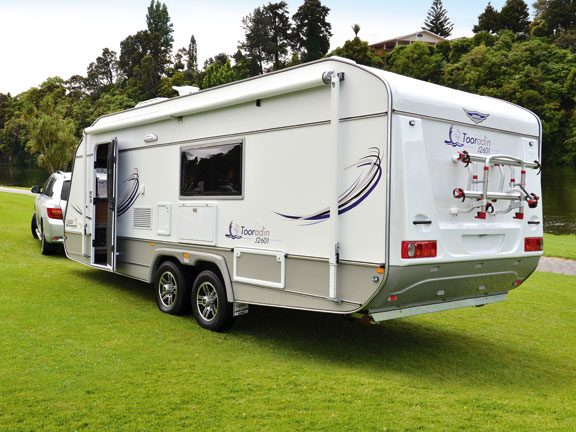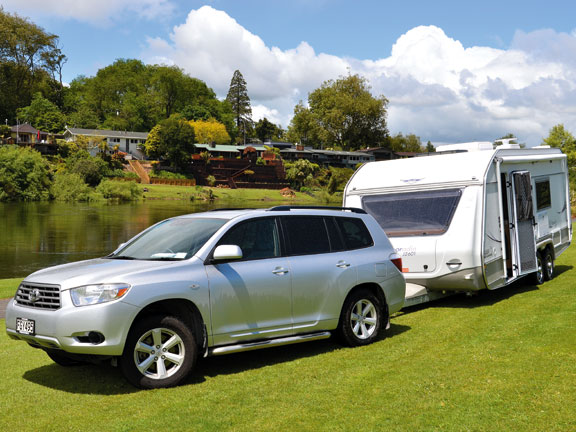“Something unique and distinctive” is the dominant impression on first entering the J2601, and that's largely a function of its defining feature – the unusual, angled bed located towards the back of the caravan.
But the bed also (in my view) creates a more functional layout – one that offers a better flow between bedroom, bathroom, kitchen and lounge/dinette – than in the J2603.
For its part, the J2603 has the bedroom up front, offering much better access to the queen-sized island bed. But it comes with a compromise – the bed's position eliminates the J2601's external kitchen (more on this in a moment) – and I don't fancy entering the caravan into what is effectively the bedroom.
First though, let's consider both caravans' overall features. They're exceptionally well-appointed with quality fittings and appliances – contemporary Euro styling with rich, warm tones offset by clever use of LED lighting. There are lots of curved surfaces and edges, something that translates into a friendlier, welcoming interior.
Large, double-glazed windows and overhead skylights let in plenty of air and natural light, and a reverse-cycle air-con unit on the roof will help to keep the internal temperature at an even keel. All windows are fitted as standard with blinds and flyscreens.
Both are fitted with the identical, full-width bathroom in the rear. It offers great space (accentuated by the large mirrors), with the shower in a separate cubicle (it has a built-in seat) and a washing machine hidden discreetly behind the toilet. The caravans are both equipped with 160-litres of fresh water (in twin 80-litre tanks).
Both vehicles are billed as four-berth models, with their dinette settees deploying into a second double bed. But given the different shapes (and location) of the two dinettes, the beds have different sizes. The J2601's bed measures 1920mm x 1140mm, compared with the J2603's 2010mm x 870mm.
The spacious kitchens are a treat (identical, but on different sides), with good working surfaces, a four-plate hob (three gas, one electric), oven and grill, and a 23-litre microwave oven. A crockery set for six is standard, and it lives in purpose-designed lockers and drawers. All very functional, pragmatic and nicely-styled. The 12-volt rangehood will help dissipate cooking aromas too.
Both caravans are built on the identical chassis equipped with double axles and independent suspension, and with electric braking on all four wheels. That, together with a relatively low-profile, streamlined shape contributes to easy towing and good stability. Their tare weight isn't particularly taxing – the angled-bed J2601 model tips the scales at 2295kg, 45kg heavier than the J2603. Our test model was towed by a 3.3-litre Toyota Highlander V6 – and it barely raised a sweat. I liked the caravan's snazzy mag wheels too.
Both models carry twin 4.5kg gas bottles in a large locker up front (it also holds a spare wheel, so this is easy to access when you need it) and a bike rack is fitted to the back.
Choosing between them, overall it's the angled bed which swings the greater number of ticks the J2601's way.
Hot Angles
Tucked towards the rear, just in front of the bathroom, the bed not only creates a more interesting interior, but also a cosier, more private bedroom. It's slightly more separated from the rest of the caravan.
This layout pushes the kitchen to the opposite side of the caravan, where it easily services the dinette (the settees are covered in leather upholstery, by the way) alongside, further forward. A three-way 180-litre fridge with separate freezer lives on the opposite side, flanked by a spacious pantry and large locker.
With the J2603, the island bed offers the advantage of His & Hers lockers either side, but it means the bedroom is really 'in your face' when you enter the vehicle, even though the door is a little further back than in the J2601. The TV/DVD player is more accessible on the J2603 – it's easily oriented to either the lounge or the bed. With the J2601, you may be forced to fit a second unit for bed viewing.
The J2603's layout has the kitchen and dinette split (on opposite sides in the middle of the caravan), so serving delicacies to the guests is perhaps a little easier than with the J2601. It's not a bad configuration, but at the risk of sounding prudish, I'm not overly keen on the kitchen and fridge being located right next to the bathroom.
But perhaps the biggest advantage you'll need to consider when weighing up the two layouts is the external, slide-out kitchen provided with the J2601. The designers have used the space under the angled bed to create a drawer (containing a cooker and wash-up sink); a neat feature that lends itself to alfresco dining and washing grubby dishes afterwards.
With its bed up front and the kitchen installed against the near side, there's no space for such a slide-out kitchen option in the J2603.
Just alongside the slide-out kitchen, the J2601 also has a fold-down ledge (built into the side of the caravan) that's perfect for any dining accessories, freeing up space on the actual outside table. Both ledge and slide-out kitchen are well-positioned under the Dometic awning, so you can cook outside even if it happens to be raining.
Both models also have built-in wine chillers, but I prefer where the J2601's is mounted: right next to the front door – easy to reach in and grab another bottle.
Tough love
The Tooradins were supplied to us by Hamilton's Jurgens agent, Auto, Leisure & Marine Group. The company says the caravans, as is standard with all Jurgens models, come with a three-year factory warranty. To that end the body – built from composite walls and one-piece aluminium roof – is mounted on a galvanised chassis.
You may also be interested to know that the caravan has been subjected to Australia's notorious 'Torture Test'; a gruelling, spine-rattling event equating to hundreds of kilometres over very rough terrain. It passed with flying colours.
Accepting that every couple's/family's caravanning preferences are different and unique, it's worth viewing the two J26 models side-by-side if possible to capture both their advantages and disadvantages. Both will provide for great touring holidays – but if you're searching for something a little exclusive, you may find yourself “leaning at an angle.”
Feel free to make a comment or ask us a question about this story on the MCD  page.
page.
For the latest reviews, subscribe to our Motorhomes, Caravans & Destinations magazine here.










